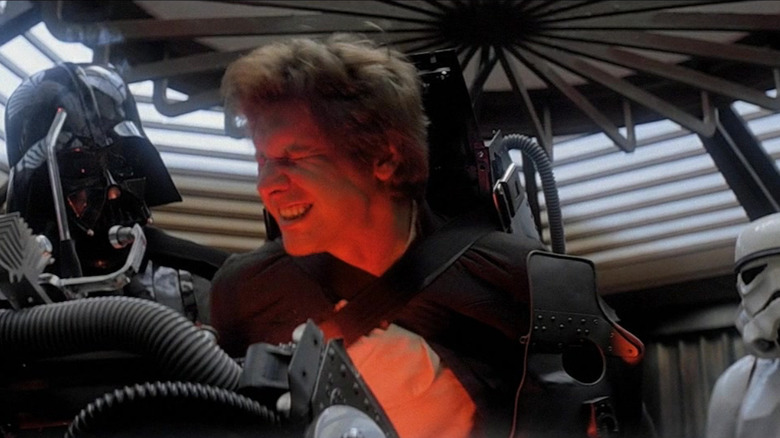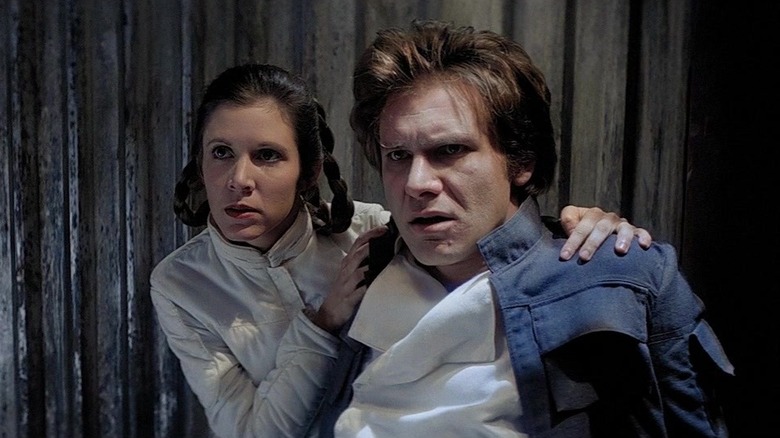Star Wars: The Empire Strikes Back Initially Had A More Brutal Han Solo Torture Scene
One of the most memorable traits of the roguish Han Solo is just how lucky he is. Depending on which version of "Star Wars: Episode IV — A New Hope" you watched, this guy somehow managed to avoid getting shot by a bounty hunter despite being mere feet away from the guy either before or after they yelled "Maclunkey!" at him. He also spent years fleeing from the evil space gangster Jabba the Hutt — and when Jabba did finally catch him, Han had already made friends with a powerful young Jedi who could rescue him not long after.
Even on a meta level, Han's a lucky guy. Harrison Ford thought Han should've died in "Return of the Jedi" to lend some "gravitas and emotional weight" to the third film, and I don't think he was wrong: "Return of the Jedi" was a little too cutesy of a follow-up to the much darker and more mature "Empire Strikes Back," and letting Han die a heroic death would've gone a long way in making it not feel so fluffy and safe. Nevertheless, creator George Lucas chose to keep Han alive, which meant Ford had to return to the role 30 years later for "The Force Awakens." Smuggling scoundrels with hearts of gold rarely live to old age, but "Star Wars" let Han pull the feat off.
As "Empire" director Irvin Kershner explained in a 2000 issue of "Star Wars: The Annotated Screenplays," Han's luck goes even deeper. When he was captured by Vader in "Empire," he was originally supposed to suffer a lot more. "I originally filmed more shots of Solo as he is being tortured," Kershner explained. "There were flashes of electricity everywhere. But it was cut out because we were afraid it might be too intense for children."
Why going easy on Han might've been the right choice
It's hard to blame Lucas too much for the decision to spare us Han's torture scenes, as "Empire" was already a pretty dark movie. It's a movie where all our heroes fail in some major, seemingly-irreversible way; Han's captured, Luke loses a hand, and Leia makes out with her brother. Everyone's taking L's here, and maybe it was best to not rub that in too much. The Vader reveal alone was enough to horrify audiences; we didn't need to watch Han get tortured to understand that we were watching the trilogy's dreaded act II low point unfold before our eyes.
It also helps that the movie already includes a short glimpse of Han about to be tortured, followed by the sound of him screaming off-camera. The movie doesn't linger on this much, but it gives us more than enough details to imagine what Han's going through. "He won't be harmed permanently," Vader says — it's technically reassuring, but considering Han's screams are still lingering in our ears, it's one of the villain's most unsettling lines.
A similar situation played out in the "Star Wars" sequel movies, except this time it was Chewbacca who supposed to be shown getting tortured. There was meant to be a super dark, emotional scene where Kylo Ren would brutally interrogate our favorite furry friend in "The Rise of Skywalker," but that was also thankfully cut from the finished product. Nobody wants to watch Han or Chewie get tortured, it seems. As many questionable choices as the "Star Wars" franchise has made over time, at least the movies have always seemed to understand this one basic rule: When things get too dark, sometimes it's best to cut away.

